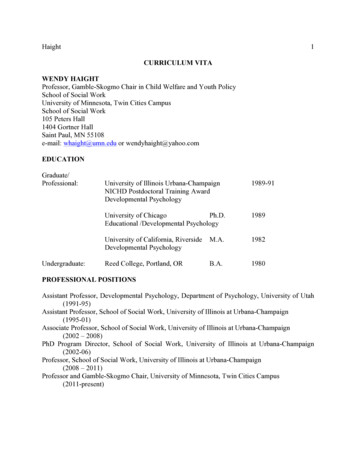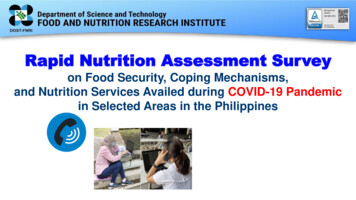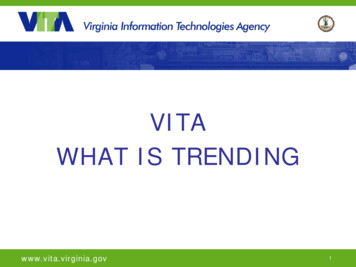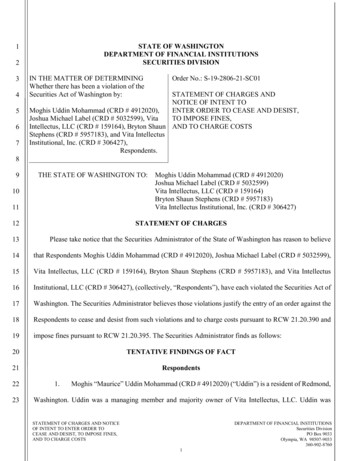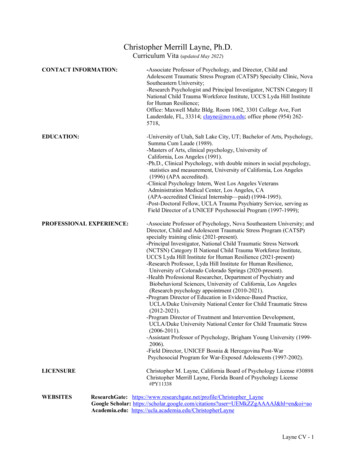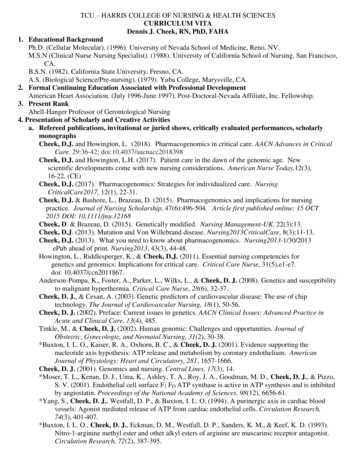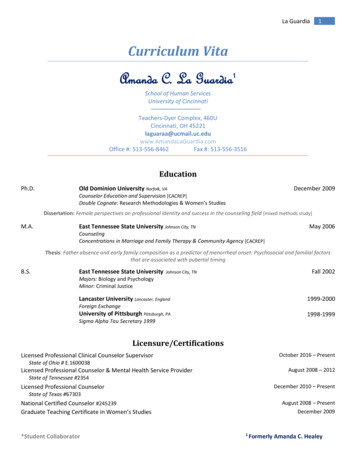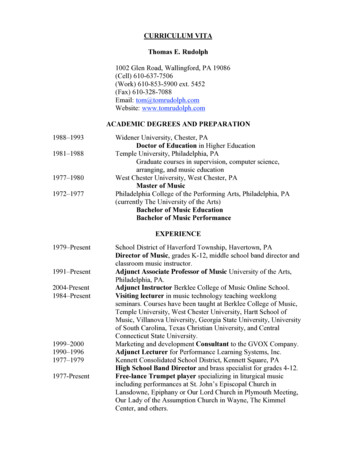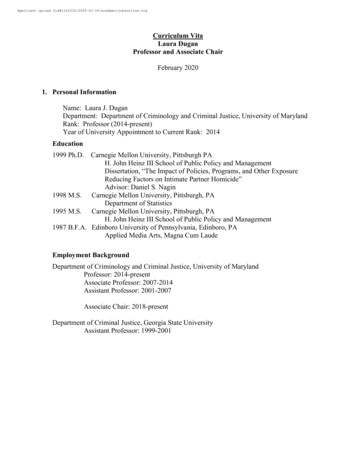
Transcription
Applicant upload culum VitaLaura DuganProfessor and Associate ChairFebruary 20201. Personal InformationName: Laura J. DuganDepartment: Department of Criminology and Criminal Justice, University of MarylandRank: Professor (2014-present)Year of University Appointment to Current Rank: 2014Education1999 Ph.D.Carnegie Mellon University, Pittsburgh PAH. John Heinz III School of Public Policy and ManagementDissertation, “The Impact of Policies, Programs, and Other ExposureReducing Factors on Intimate Partner Homicide”Advisor: Daniel S. Nagin1998 M.S. Carnegie Mellon University, Pittsburgh, PADepartment of Statistics1995 M.S. Carnegie Mellon University, Pittsburgh, PAH. John Heinz III School of Public Policy and Management1987 B.F.A. Edinboro University of Pennsylvania, Edinboro, PAApplied Media Arts, Magna Cum LaudeEmployment BackgroundDepartment of Criminology and Criminal Justice, University of MarylandProfessor: 2014-presentAssociate Professor: 2007-2014Assistant Professor: 2001-2007Associate Chair: 2018-presentDepartment of Criminal Justice, Georgia State UniversityAssistant Professor: 1999-2001
2. Research, Scholarly, and Creative Activities* University of Maryland current or former graduate studenta. Books1. LaFree, Gary, Laura Dugan, and Erin Miller* (2015), Putting Terrorism into Context:Lessons Learned from the World’s Most Comprehensive Terrorism Database, New York,NY: Routledge.b. Chapters in Books2. Erica Chenoweth and Laura Dugan (2020) “Deterrence or Blowback? The Consequencesof Canadian Counterterrorism in Afghanistan.” In J. Littlewood, L. Dawson, and S.Thompson (Eds.) Terrorism and Counterterrorism in Canada. Toronto, CA: Universityof Toronto Press.3. Daren G. Fisher* and Laura Dugan (2019) “Sociological and CriminologicalExplanations of Terrorism.” In E. Chenoweth, A. Gofas, R. English, and S. Kalyvas(Eds.) Oxford Handbook on Terrorism (pp. 163-176). New York: Oxford UniversityPress.4. LaFree, Gary and Laura Dugan (2017) “Evolution of Global Terrorism The Growth ofLethality of Attacks.” In D.A. Backer, R. Bhavnani, and P.K. Huth (Eds.) Peace &Conflict 2017, Abingdon, UK: Routledge, Taylor & Francis Group.5. Laura Dugan and Erica Chenoweth (2017) “Introducing Government Actions in TerrorEnvironments (GATE) Dataset.” In M. Stohl, R. Burchill, S.H. Englund (Eds.)Constructions of Terrorism An Interdisciplinary Approach to Research and Policy.Oakland, CA: University of California Press.6. LaFree, Gary and Laura Dugan (2016) “Global Terrorism and the Deadliest Groups since2001.” In D.A. Backer, J. Wilkenfeld, and P.K. Huth (Eds.) Peace & Conflict 2016,Abingdon, UK: Routledge, Taylor & Francis Group.7. Dugan, Laura and Michael Distler* (2016) “Measuring Terrorism.” In G. LaFree and J.Freilich (Eds.) pp. 189-205, Handbook on the Criminology of Terrorism, Hoboken, NJ:Wiley Press.8. Dugan, Laura (2016) “Terrorism.” In W.G. Jennings (Ed.) The Encyclopedia of Crimeand Punishment, Malden, MA: Wiley-Blackwell.9. Dugan, Laura and Daren G. Fisher* (2015) “Strategic Responses to the Boston MarathonBombing.” In M. Tonry (Ed.) Oxford Handbooks Online. New York: Oxford 9780199935383-e-9910. LaFree, Gary and Laura Dugan (2015) “How has Criminology Contributed to the Studyof Terrorism since 9/11?” In M. Deflem (Ed.) Terrorism and Counterterrorism Today,Sociology of Crime, Law and Deviance (pp 3-23), Volume 20, Bingley, UK: Emerald.11. LaFree, Gary and Laura Dugan (2014) “Global Trends in Terrorism, 1970-2011” (pp2942) in Peace and Conflict 2014, eds. David A. Backer, Jonathan Wilkenfeld, and Paul K.Huth, Boulder, CO: Paradigm Publishers.12. Dugan, Laura (2013) “Counterterrorism.” In G. Bruinsma and D. Weisburd (Eds.)Encyclopedia of Criminology and Criminal Justice, New York: Springer.2
13. Dugan, Laura and Erica Chenoweth (2013) “Government Actions in TerrorEnvironments (GATE): A Methodology that Reveals how Governments Behave towardTerrorists and their Constituencies.” In V.S. Subrahmanian (Ed.) Handbook ofComputational Approaches to Counterterrorism (pp 467-488), New York: Springer.14. LaFree, Gary and Laura Dugan (2013) “The Global Terrorism Database: 1970-2010.” InV.S. Subrahmanian (Ed.) Handbook of Computational Approaches to Counterterrorism(pp 3-22), New York: Springer.15. Dugan, Laura (2012) “The Making of the Global Terrorism Database and ItsApplicability to Studying the Lifecycles of Terrorist Organizations.” In D. Gadd, S.Karstedt, and S. Messner (Eds.) The Sage Handbook of Criminological ResearchMethods (pp 175-198), Los Angeles, Sage.16. LaFree, Gary and Laura Dugan (2012) “Trends in Global Terrorism, 1970 to 2008,”(pp39-52) in Peace and Conflict 2012, eds. J. Joseph Hewitt, Jonathan Wilkenfeld, TedR. Gurr. Boulder, Colorado: Paradigm Publishers.17. Dugan, Laura and Sue-Ming Yang* (2011) “Introducing Group-Based TrajectoryAnalysis and Series Hazard Modeling: Two Innovative Methods to SystematicallyExamine Terrorism Over Time,” (pp 113-147) in C Lum and L. Kennedy (eds.)Evidence-Based Counterterrorism Policy, New York: Springer.18. Dugan, Laura (2010) “Estimating Effects over Time for Single and MultipleObservations.” In A. Piquero and D. Weisburd (Eds.) Handbook of QuantitativeCriminology. (pp. 741-763) New York: Springer.19. LaFree, Gary, Laura Dugan, and Kim Cragin (2010) “Trends in Terrorism, 1970-2007.”In Peace and Conflict, eds. J. Joseph Hewitt, Jonathan Wilkenfeld, Ted R. Gurr. Boulder,(pp. 51-64). Colorado: Paradigm Publishers.20. LaFree, Gary and Laura Dugan (2009) “Tracking Global Terrorism Trends, 1970-2004.”In T. Feucht and D. Weisburd (Eds.) To Protect and Serve: Dilemmas in Policing andTerrorism and Serving the Public. New York: Springer.21. Dugan, Laura (2009) “Terrorism.” In M. Tonry (Ed.) Handbook on Crime and PublicPolicy. New York, NY: Oxford Press.22. Dugan, Laura and Carole Gibbs* (2008) “The Role of Organizational Structure in theEtiology and Control of Corporate Crime and Terrorism.” In S. Simpson and D.Weisburd (Eds.) The Criminology of White-Collar Crime Springer.23. Mattingly, Marybeth J.* and Laura Dugan (2008) “How Female Victims’ ResponsesAffect the Risk of Future Assaults by Their Male Intimate Partners.” In Keeling, June andTom Mason (Eds.) Domestic Violence, Berkshire, England: Open University Press.24. LaFree, Gary, Laura Dugan, and Susan Fahey* (2007) “Global Terrorism and FailedStates.” In Peace and Conflict, eds. J. Joseph Hewitt, Jonathan Wilkenfeld, Ted R. Gurr.Boulder, Colorado: Paradigm Publishers.25. LaFree, Gary, Nancy Morris,* Laura Dugan, and Susan Fahey* (2006) “IdentifyingGlobal Terrorist Hot Spots.” In Victoroff, J. (Ed.) pp. 98-114 Tangled Roots: Social andPsychological Factors in the Genesis of Terrorism. Amsterdam: IOS Press.26. Dugan, Laura and Jennifer Castro* (2005) “Comparing Predictors of ViolentVictimization for NCVS Women with Those for Incarcerated Women,” in Karen Heimer3
and Candace Kruttschnitt (Eds.) Gender and Crime: Patterns in Victimization andOffending. New York: New York University Press.27. Dugan, Laura, Daniel S. Nagin, and Richard Rosenfeld. (2004) "The Effects of Stateand Local Domestic Violence Policy on Intimate Partner Homicide." Pp. II-6-1 - II-6-10in Bonnie S. Fisher, ed. Violence Against Women and Family Violence: Developments inResearch, Practice, and Policy. Washington, DC: National Institute of Justice, (availableat http://www.ncjrs.org/pdffiles1/nij/199701.pdf).28. LaFree, Gary and Laura Dugan, (2004) “How Does Studying Terrorism Compare toStudying Crime?” Pp. 53-74 in M. DeFlem, ed., Terrorism and CounterTerrorism: Criminological Perspectives. New York: Elsevier.c. Articles in Referred Journals29. Fisher, Daren G.* and Laura Dugan (2019) “The Importance of Governments’ Responseto Natural Disasters to Reduce Terrorist Risk” Justice Quarterly. Online first, 15 Nov2019. https://doi.org/10.1080/07418825.2019.168512030. Carson, Jennifer*, Laura Dugan, and Sue-Ming Yang* (2019) “A comprehensiveapplication of rational choice theory: How costs imposed by, and benefits derived from,the U.S. federal government affect incidents perpetrated by the radical eco-movement,”Journal of Quantitative Criminology. Online first, 30 August 2019.https://doi.org/10.1007/s10940-019-09427-831. Fisher, Daren G.*, Laura Dugan, and Erica Chenoweth (2018) “Does US PresidentialRhetoric Affect Asymmetric Political Violence?” Critical Studies on Terrorism,Published online first, July 11, 2018 DOI: 10.1080/17539153.2018.149412032. Simpson, Sally S., Mariel Alper*, Laura Dugan, Julie Horney, Candace Kruttschnitt, andRosemary Gartner (2016) “Age-Graded Pathways into Crime: Evidence from a MultiSite Retrospective Study of Incarcerated Women,” Journal of Developmental and LifeCourse Criminology, 2 (3):296-320.33. Chenoweth, Erica and Laura Dugan (2016) “The Canadian Way of Counterterrorism:Introducing the GATE-Canada Dataset,” Canadian Foreign Policy Journal, 22 (3): 316330.34. Young, Joseph K. and Laura Dugan. (2014) “Survival of the Fittest: Why TerroristGroups Endure,” Perspectives on Terrorism, 8 (2): 2-23.35. Dugan, Laura and Gary LaFree. (2013) “Measuring Terrorist Attacks with Open SourceData,” International Studies Review, 14:475-497.36. Dugan, Laura and Erica Chenoweth. (2012) “Moving Beyond Deterrence: TheEffectiveness of Raising the Expected Utility of Abstaining from Terrorism in Israel,”American Sociological Review, 77 (4), 597-624.37. Carson, Jennifer Varriale,* Gary LaFree, and Laura Dugan. (2012) “Terrorist and Nonterrorist Criminal Activities by Radical Environmental and Animal Rights Groups in theUnited States, 1970-2007,” Terrorism and Political Violence, 24: 295-319.38. Apel, Robert,* Laura Dugan, and Ráchael Powers*. (2012) “Gender and Injury Risk inIncidents of Assaultive Violence,” Justice Quarterly, 30: 561-593.4
39. Fahey, Susan,* Gary LaFree, Laura Dugan, and Alex Piquero. (2012) “A SituationalModel for Distinguishing Terrorist and Non-Terrorist Aerial Hijackings, 1948 to 2007,”Justice Quarterly, 29: 573-595.40. LaFree, Gary, Laura Dugan, Min Xie, and Piyusha Singh. (2012) “Spatial and TemporalPatterns of Terrorist Attacks by ETA,” Journal of Quantitative Criminology, 28: 7-29.41. Dugan, Laura. (2011) “The Series Hazard Model: An Alternative to Time Series forEvent Data,” Journal of Quantitative Criminology, 27: 379-402.42. Young, Joseph and Laura Dugan (2011) “Veto Players and Terror,” Journal of PeaceResearch, 48: 19-33.43. LaFree, Gary, Nancy Morris,* and Laura Dugan. (2010) “Cross-National Patterns ofTerrorism: Comparing Trajectories for Total, Attributed and Fatal Attacks, 1970-2006,”British Journal of Criminology 50: 622-649.44. LaFree, Gary and Laura Dugan (2009) “Research on Terrorism and CounteringTerrorism,” Crime and Justice 38: 413-477.45. LaFree, Gary, Laura Dugan, and Raven Korte,* (2009) “The Impact of BritishCounterterrorist Strategies on Political Violence in Northern Ireland: ComparingDeterrence and Backlash Models,” Criminology, 47: 17-45.46. Dugan, Laura, Julie Huang, Gary LaFree, and Clark McCauley. (2008) “The ArmenianSecret Army for the Liberation of Armenia and the Justice Commandos of the ArmenianGenocide.” Dynamics of Asymmetric Conflict, 1: 231-249.47. Simpson, Sally S., Jennifer L. Yahner,* and Laura Dugan, (2008) “UnderstandingWomen’s Pathways to Jail: A Life History Analysis of the Lives of IncarceratedWomen,” Australian and New Zealand Journal of Criminology, 41: 84-108.48. LaFree, Gary and Laura Dugan, (2007) “Introducing the Global Terrorism Database,”Terrorism and Political Violence, 19:181-204.49. Greenbaum, Robert, Laura Dugan and Gary LaFree, (2007) “The Impact of Terrorism onItalian Employment and Business Activity,” Urban Studies, 44:1093–1108.50. Dabney, Dean A., Laura Dugan, Volkan Topalli, and Richard C. Hollinger, (2006) “TheImpact of Implicit Stereotyping on Offender Profiling: Unexpected Results from anObservational Study of Shoplifting,” Criminal Justice and Behavior, 33: 646-674.51. Dugan, Laura, Gary LaFree, and Alex Piquero, (2005) “Testing a Rational Choice Modelof Airline Hijackings,” CRIMINOLOGY, 43:1031-1066.52. Dugan, Laura and Robert Apel (2005) “The Differential Risk of Retaliation by RelationalDistance: A More General Model of Violent Victimization,” CRIMINOLOGY, 43: 697730.53. LaFree, Gary, Laura Dugan, and Derrick Franke* (2005) “The Interplay betweenTerrorism, Nonstate Actors, and Weapons of Mass Destruction: An Exploration of thePinkerton Database,” International Studies Review, 7:155-158.54. Dabney, Dean A., Richard C. Hollinger and Laura Dugan, (2004) “Who Actually Steals?A Study of Covertly Observed Shoplifters,” Justice Quarterly, 21:693-725.5
55. Finn, Mary, Brenda Sims Blackwell, Loretta Stalans, Sheila Studdard*, and LauraDugan, (2004) “The Effect of Policy, Injury, and Officer Perceptions on Arrest Decisionsin Domestic Violence Cases,” Crime & Delinquency, 50:565-589.56. LaFree, Gary and Laura Dugan, (2003) "Una Comparación del Estudio del Terrorismo yel Estudio de la Delincuencia". Revista Cenipec (Mérida, Venezuela) 22:107-143.Translation: “A Comparison Study of Terrorism and Transnational Studies.” MagazineCenipec.57. Dugan, Laura and Robert Apel* (2003) “An Exploratory Study of the ViolentVictimization of Women: Race/Ethnicity and Situational Context,” CRIMINOLOGY,41:959-980.58. Dugan, Laura, (2003) “Domestic Violence Legislation: Exploring Impacts on DomesticViolence and the Likelihood that Police are Informed and Arrest,” CRIMINOLOGY &Public Policy, 2 (2): 283-312.59. Dugan, Laura, Daniel Nagin, and Richard Rosenfeld, (2003) “Exposure Reduction orRetaliation? The Effects of Domestic Violence Resources on Intimate PartnerHomicide,” Law & Society Review, 27 (1): 169-198.60. Dugan, Laura, (2002) “Identifying Unit-Dependency and Time-Specificity inLongitudinal Analysis: A Graphical Methodology,” Journal of QuantitativeCriminology, 18(3):213-237.61. Feder, Lynette and Laura Dugan, (2002) “A Test of the Efficacy of Court-MandatedCounseling for Domestic Violence Offenders: The Broward Experiment,” JusticeQuarterly, 19 (2): 343-375.62. Dugan, Laura, (1999) “The Effect of Criminal Victimization on a Household’s MovingDecision.” CRIMINOLOGY, 37(4): 901-829.63. Dugan, Laura, Daniel Nagin, and Richard Rosenfeld, (1999) “Explaining the Decline inIntimate Partner Homicide: The Effects of Changing Domesticity, Women’s Status, andDomestic Violence Resources.” HOMICIDE STUDIES, 3(3):187-214.d. Other Published Reports64. Mattingly, Marybeth J.* and Laura Dugan (2009). “Unemployment Insurance: A SafetyNet for Victims of Intimate Partner Violence and Their Children,” Carsey Institute FactSheet No. 15. Summer 2009.65. Dugan, Laura, Daniel Nagin, and Richard Rosenfeld, (2003) “Do Domestic ViolenceServices Save Lives?” National Institute of Justice Journal, Issue no. 250.e. Government Reports66. Chenoweth, Erica, Laura Dugan, and Daren G. Fisher,* The Causes and Effects ofCanadian Counterterrorism: Insights from the GATE-Canada Dataset. Final Report forPublic Safety Canada, 2015.67. LaFree, Gary, Laura Dugan, and Erin Miller,* Integrated United States Security Database(IUSSD): Terrorism Data on the United States Homeland, 1970 to 2011. Final Report toHuman Factors/Behavioral Sciences Division, DHS Science and Technology Directorate,November 2012, College Park, MD: START, 2012.6
68. Dugan, Laura, Gary LaFree, Kim Cragin, and Anna Kasupski, (2008) Building andAnalyzing an Open Source Comprehensive Data Base on Global Terrorist Events. AFinal Report to the National Institute of Justice for Grant # 2005-IJ-CX-0002.69. LaFree, Gary, Laura Dugan, Heather Fogg,* and Jeffrey Scott,* (2006) Building a GlobalTerrorism Database. A Final Report to the National Institute of Justice for Grant # 2002DT-CX-0001.70. Cohen, Jacqueline and Laura Dugan, (2005) “Influence of Individual, Situational, andCommunity Context on Assault Incidents Detected in Official Agency Records.” Achapter in Exploring Alternative Data Sources for the Study of Assault, a final Report tothe National Institute of Justice for Grant # 98-MU-MU-0007.71. Dugan, Laura and Marybeth J. Mattingly,* (2004) Family and EmploymentConsequences of Intimate Partner Violence: A Longitudinal Analysis. A final Report tothe National Institute of Justice for Grant # 2002-IJ-CX-0012.72. Dugan, Laura and Marybeth J. Mattingly,* (2004) Factors Affecting Repeated Incidentsof Intimate Partner Violence by Race and Ethnicity. A final Report to the AmericanStatistical Association and the Bureau of Justice Statistics.73. Dugan, Laura (2002) Domestic Violence Policy: Exploring Impacts on Informing Police,Arresting the Offender, and Deterring Domestic Violence. A final Report to the NationalInstitute of Justice for Grant # 97WTVX0004.74. Dugan, Laura, Daniel Nagin, and Richard Rosenfeld, (2000) Exposure Reduction orBacklash? The Effects of Domestic Violence Resources on Intimate Partner Homicide.A Final Report to the National Institution of Justice for Grant # 97WTVX0004f. Works in Progress75. “Emboldenment or Threat: The Effects of Political Power on Violent Hate Crimes” withErica Chenoweth (redrafting)76. “ “Global Terrorism and Armed Conflict” with Gary LaFree and Michael Fuerstenberg(under review)77. “Mitigating Further Harm: The importance of Governments’ Response to NaturalDisasters to Reduce Terrorist Risk in the Philippines, Turkey, and the United Kingdom,”with Daren Fisher (redrafting)78. “Crime, Politics, Ethnicity, Gender, and Power in Transnational and ComparativePerspective,” with Michael Distler* and Victor Asal (redrafting)79. “Rethinking Counterterrorism: Evidence from Israel,” with Erica Chenoweth (redrafting)80. “Relative Deprivation, Rational Choice, and Abortion Clinic Violence in the UnitedStates, 1976 to 2005,” with Bradley Bartholomew* and Gary LaFree (redrafting)81. “The Pursuit of Aid: Help-Seeking for Intimate Partner Violence in the DevelopingWorld,” with Megan Bears Augustyn* and Brandon Behlendorf* (redrafting)g. Talks, Abstracts, and Other Papers PresentedL. Dugan is sole presenter unless otherwise noted.i. Invited Talks, etc.7
Invited Talks:82. Dugan, Laura, “Methodologies and the Media in Countering Violent ExtremismResearch,” RESOLVE Network 2019 Global Forum, Resetting Priorities to AddressViolent Extremist Threats, U.S. Institute of Peace, September 2019.83. Dugan, Laura, “Extremist Violence: Do U.S. Government Actions Make it Worse?” GaryKing Visiting Lecture in Applied Social research series, April 2019.84. Dugan, Laura, “Do Federal US Actions Influence Rightwing Violence?,” CongressionalBriefing: Violence and Violence Prevention, Rayburn House Building, Washington, DC,September 2016.85. Dugan, Laura, “US Actions During the Clinton Years Relevant to Extremist Violence,”Strategic Multi-Layer Assessment (SMA) Speakers Series Telecon, via conference call,June 2016.86. Dugan, Laura, “How United States and Canadian Actions Affect Jihadi Violence,”Constructions of Terrorism: Confronting the Challenges to Global Security Created byDaesh/Islamic State, TRENDS Research & Advisory, Orfalea Center for Global &International Studies, and The Stimson Center, Washington, DC, April 2016.87. Dugan, Laura, “Introducing Government Actions in Terror Environments (GATE)Dataset,” Constructions of Terrorism Conference, Orfalea Center for Global &International Studies, University of California-Santa Barbara, December 2015.88. Dugan, Laura, “Terrorism and Crime: How Criminologists Contribute to Understandingand Reducing Terrorism,” Faculty Seminar, School of Criminology and Justice Studies atUniversity of Massachusetts-Lowell, October 2015.89. Dugan, Laura, “A Broader Understanding to Countering Terrorism,” Seminar for PhDStudents, Florida International University, School of International & Public Affairs,October 2015.90. Dugan, Laura, “Government Actions in Terror Environments: Moving BeyondDeterrence,” START Annual Meeting, September 2014.91. Dugan, Laura, “Regional Strategic Initiative Algeria Program Evaluation,” withDevelopment & Training Services, Inc. for the Office of Strategic Programs and Policy,Bureau of Counterterrorism, U.S. Department of State, September 2014.92. Dugan, Laura, “Collecting Government Actions in Terror Environments (GATE),” LargeScale Data in the Study of Contentious Politics meeting, University of North CarolinaChapel Hill, April 2014.93. Dugan, Laura, “A Broader Understanding to Countering Terrorism,” Dean’sDistinguished Lecture Series, University of Texas San Antonio, College of Public Policy,February 2014.94. Dugan, Laura, “Government Actions in Terror Environments (GATE) in the MiddleEast,” Strategic Multi-Layer Assessment (SMA) Speakers Series Telecon, via conferencecall, October 2013.95. Dugan, Laura, “Efforts to Control Terrorism in the Middle East,” Director’s SpeakerSeries, Mershon Center for International Security Studies, The Ohio State University,Columbus, OH, September 2013.8
96. Dugan, Laura, “Introduction to the GTD and GATE Collection,” Best Practices inConflict Data Collection conference for the Conflict Consortium, Ann Arbor, MI, May2013.97. Dugan, Laura, “Terrorism and Crime: Their Similarities, Differences, and LessonsLearned,” Research Lecture Series, University of South Florida, Department ofCriminology, April 2013. Criminology in Practice Seminar, University of Pennsylvania, Department ofCriminology Masters of Science Candidates, September 2012.98. Dugan, Laura, “Global Terrorism Database (GTD) Introduction,” National Security DataInitiative database workshop, Public Safety Canada, Ottawa, ON, Canada, March 2013.99. Dugan, Laura, “Deterring Terrorism: Lessons Learned in Social Science Research,”Algorithm Development for Security Applications (ADSA) Workshop, Boston, MA,October 2012.100.Dugan, Laura, “Moving Beyond Deterrence: The Effectiveness of Raising theBenefits of Abstaining from Terrorism in Israel,” Brown Bag Seminar at the Departmentof Homeland Security (DHS), Washington, DC, June 2012. June 2011.101.Dugan, Laura, “Using the NCVS to Understand Sexual Violence,” The NationalAcademies, First Meeting of the Panel on Measuring Rape and Sexual Assault I Bureauof Justice Statistics Household Surveys, Washington, DC, December 2011.102.Erica Chenoweth and Laura Dugan, “Does Repression Decrease TerroristAttacks? Evidence from Israel,” Daniel Rose Technion-Yale seminar in CounterterrorOperations Research, Yale University, New Haven, CT, February 2011.103.Dugan, Laura, “Evaluating the Full Spectrum of Efforts by the State to ControlTerrorism,” Colloquium on U.S. National Security Policy and Military Strategy:Understanding the Environment for Contemporary Warfare, Texas Tech University,Lubbock, TX, September 2010.104.Dugan, Laura, “Evaluating the Full Spectrum of Efforts by the State to ControlTerrorism,” Quantitative Methods in Defense and National Security conference, Fairfax,VA, May 2010.105.Dugan, Laura, “Terrorism and Crime: Their Similarities, Differences, andLessons Learned,” Crime and Terrorism Conference, Southern Illinois UniversityCarbondale, keynote speaker Carbondale, IL, April 2010.106.Dugan, Laura, “What is Known About Mandatory Arrest for Intimate PartnerViolence,” Congressional Briefing: Evidence-Based Crime Policy: What We Know,What We Need to Know, Washington, DC, October 2009.107.Dugan, Laura, “Quantitative Terrorism Research,” National Institute of JusticeAnnual Conference, Washington, DC, June 2009.9
108.Dugan, Laura, “Examining Patterns of Activity Across Organizations,” JointResearch Meeting on Radicalization and Counter-Radicalization, Washington, DC April2009.109.Dugan, Laura, “Helping the Victim Get Help: Toward a Strategy to ReduceIntimate Violence,” Congressional Briefing: Advancing Evidence-Based Policy inPolicing, Washington, DC, February 2009.110.Dugan, Laura, “Organizational Trajectories of Terrorism Activity,” Departmentof Defense-Department of Homeland Security Social Science Modeling and InformationVisualization Symposium, Arlington, VA, January 2008.111.Dugan, Laura, “The Global Terrorism Database and Its Application to estimatingCounter-Terrorism Strategies in Northern Ireland, 1969-1992,” Congressional Briefing:Evidence-Based Counterterrorism Policy: New Research Findings, Washington, DC,September 2007.112.Dugan, Laura, “A More Sophisticated Look at the Global Terrorism Database,”2007 Homeland Security Stakeholders Conference: A World of Change, Washington,DC, May 2007.113.Dugan, Laura, “Deterring Terrorism: Insights from Three START Projects,”Institute for Defense Analyses Conference on Deterring WMD Terrorism: Theory andPractice, Alexandria, VA, November 2006.114.Dugan, Laura, “A First Look at Domestic and International Global TerrorismEvents, 1970-1997,” Descartes Conference on Mathematical Models in Counterterrorism, Washington,DC, September 2006. National Institute of Justice Terrorism Research Symposium, Denver, CO, June2006. Institute of Electrical and Electronics Engineers (IEEE) Workshop on Intelligenceand Security Informatics, Singapore, April 2006.115.Dugan, Laura, “Testing A Rational Choice Model of Airline Hijackings,”Department of Homeland Security Institute’s Workshop Plenary Meeting on AdvancingAnalytic Techniques in Deterrence Analysis, Arlington, VA, September 2005.116.Dugan, Laura, “How Does Studying Terrorism Compare to Studying Crime?”Institute of Electrical and Electronics Engineers (IEEE) International Conference onIntelligence and Security Informatics, Atlanta, GA, May 2005.117.Dugan, Laura, “Policy Effects on Intimate Partner Violence,” Maryland NetworkAgainst Domestic Violence, Multicultural Task Force Meeting, Bowie, MD, September2004.118.LaFree, Gary and Laura Dugan, “Creating and Exploiting a ComprehensiveTerrorist Event Database,” National Consortium on Violence Research Summer Workshop, Miami Beach,FL, June 2004. Department of Homeland Security, Washington, DC, January 2004.10
119.LaFree, Gary and Laura Dugan, “Creating a Comprehensive Terrorist EventDatabase,” National Consortium on Violence Research Summer Workshop, roundtableon terrorism, San Juan, PR, June 2003.120.Dugan, Laura, “Using Resource Data Center Resources to Study Crime,” NationalScience Foundation, RDC Research Conference, Arlington, VA, January 2003.121.LaFree, Gary and Laura Dugan, “Creating a Comprehensive Terrorist EventDatabase,” The National Academies Roundtable on Social and Behavioral Sciences andTerrorism, Washington, DC, December 2002.122.Dugan, Laura, “Policy Effects on Intimate Partner Violence,” NationalConsortium on Violence Research Summer Workshop, St. Augustine, FL, June 2002.123.Dugan, Laura, “An Exploratory Study of the Violent Victimization of Women:Race/Ethnicity, Situational Context, and Injury,” A commissioned paper and presentationfor: Expanding the Federal Research Agenda on Violence Against Women: A Workshopof the Committee on Law and Justice and the National Research Council’s Division onBehavioral and Social Sciences and Education, Washington, DC, January 2002.124.Dugan, Laura, “Exposure Reduction or Retaliation? The Effects of DomesticViolence Resources on Intimate Partner Homicide,” The Annual Conference on Criminal Justice Research and Evaluation, EnhancingPolicy and Practice, Washington, DC, July 2001. Crimes Against Children Research Center's "Decline in Sexual Abuse Cases"Panel, Sponsored by the Crimes Against Children Research Center, University ofNew Hampshire, Rockville, MD, November 2000. National Institute of Justice’s Research Conference on Violence Against Womenand Family Violence, Washington, DC, October 2000. Intimate Partner Homicide Forum, Sponsored by the Office for Victims of Crime,Washington DC, September 2000.125.Dugan, Laura, “Interpersonal Domestic Violence,” Congressional Briefing:Controlling Violence in America, Sponsored by the Consortium of Social ScienceAssociations and the National Consortium on Violence Research, Washington, DC, June2000.126.Dugan, Laura, "Impact of Policies, Programs, and Exposure-Reducing Factors onIntimate-Partner Homicide," Pennsylvania Coalition Against Domestic Violence,Washington, DC, March 2000.127.Dugan, Laura, “The Declining Rate of Intimate Partner Homicide: Demographicand Policy Analyses,” National Institute of Justice Research in Progress Seminar,Washington, DC, January 2000.128.Dugan, Laura, “The Impact of Legal Advocacy on Intimate Partner Homicide,”Violence Against Women and Family Violence Research and Evaluation ProgramAnnual Grantees Meeting, Washington, DC, June, 1999.129.Dugan, Laura, "Impact of Policies, Programs, and Exposure-Reducing Factors onIntimate-Partner Homicide," Keynote speaker: Family Violence: Research and PolicyIssues Symposium, University of Nebraska-Lincoln, Lincoln, NE, May 1999.11
Workshops and Lectures:130.Guest Lecturer, “Terrorism & Crime: How Criminologists Contribute toUnderstanding & Reducing Terrorism and Other Ideological Forms of Violence,” CurryCollege undergraduate criminology course, November 2018.131.Lecturer, “Survival of Terrorist Groups,” University of Management andTechnology, Lahore, Pakistan; Understanding, Managing and Resolution of TerrorismCourse, February 2016.132.Guest Lecturer, “Evaluating the Continuum of Efforts by the State to ControlTerrorism,” Johns Hopkins University School of Education, Division of Public SafetyLeadership, Masters of Science in Intelligence Analysis, Terrorism, Concepts, Threats,and Delivery,a. Fall 2014b. Fall 2013.c. Fall 2012.d. Fall 2011.e. Spring 2011.133.Guest Lecturer, “Longevity, Activity, and Lethality of Terrorist Organizations,”MOOC for Understanding Terrorism and the Threat of Terrorism course offered bySTART (National Consortium for the Study of Terrorism and Response to Terrorism),University of Maryland, Spring 2014.134.Guest Lecturer, “Terrorist Weapons and Tactics,” MOOC for UnderstandingTerroris
2 2. Research, Scholarly, and Creative Activities * University of Maryland current or former graduate student a. Books 1. LaFree, Gary, Laura Dugan, and Erin Miller* (2015), Putting Terrorism into Context: Lessons Learned from the World's Most Comprehensive Terrorism Database, New York, NY: Routledge.
